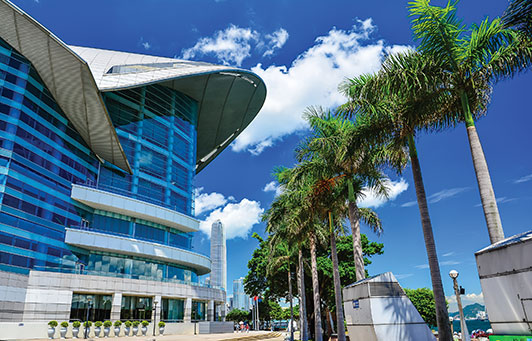Industry

Hong Kong Show Better Than Expected
Market conditions improved as retailers started restocking after the holiday season. But India’s “Mines to Market” conference noted that familiar concerns remain about the market in 2017.
By Avi Krawitz
 | | Hong Kong Convention Center. Photo: Cyrus_2000 / Shutterstock.com |
Polished diamond trading strengthened in March as the Hong Kong show signaled that Chinese jewelers are looking for goods again after being absent from the market for some time. The show was consequently better than expected for the diamond trade even as conditions favored buyers. Suppliers took the opportunity to reduce stock and generate much-needed cash flow. Prices softened slightly in certain categories but overall, the RapNet Diamond Index (RAPI™) was stable throughout the month. RAPI for 1-carat diamonds edged up .2 percent from March 1 to 27 (see RapNet Diamond Index [RAPI™] chart in slideshow). RAPI for .30-carat diamonds increased 1 percent, and RAPI for .50-carat diamonds declined .7 percent. RAPI for 3-carat diamonds grew 2 percent with improving demand for large stones ahead of the Basel show. However, dealers were mindful of the cautious trading environment as the first quarter was not as upbeat as previous years — despite the improvement in March. The first three months of the year generally sees a sharp rise in activity — and a positive price trend — as jewelers restock inventory they sold during the Christmas and Chinese New Year seasons. This year, RAPI for 1-carat fell 1 percent in the first quarter as dealers and jewelers are managing their inventory even more carefully than before.
YOU MUST HAVE JAVASCRIPT ENABLED TO VIEW THE SLIDESHOW
Jewelers are also replacing their higher-value inventory with lower-priced goods, Fischler said. That trend is stemming from the retail sector, as larger jewelers are shifting to lower-end products, which are their fastest-selling items, Yiu observed. Similarly in the U.S., where consolidation in the retail sector is influencing lower stock requirements, jewelers are shifting to lower price points, with Signet Jewelers and Tiffany & Co. noting strength in the fashion-jewelry segment. The result is that a narrower range of goods is moving in the midstream. Whereas before, the market in Hong Kong and China was characterized by better-quality VVS to VS-clarity diamonds, today, Yiu said that Hong Kong is competing with the U.S. for SI-clarity and piqué goods. The shift to lower price points is largely due to the maturing economic reality in China. Exhibitors also pointed to the fact that buyers are working with tighter budgets than they were a year ago due to fluctuations in the exchange rate. The Chinese yuan has depreciated 6 percent in the past year, which affects Chinese wholesalers who buy in U.S. dollars but sell in their local currency. Still, China’s polished trade grew in 2016 with dealers observing that some trading activity has shifted from Hong Kong to Mainland China recently. China’s imports of polished diamonds rose 5 percent to $7.02 billion in 2016, having declined the previous year, while Hong Kong’s imports were flat at $17.41 billion for the year (see China’s Polished Diamond Trade; Hong Kong’s Diamond Trade and ALROSA Revenue & Net Profit charts in slideshow). The average price of polished imports to Hong Kong declined, while those to China increased, reaching the same level of around $916 per carat in 2016.
Suppliers expressed some caution about working in China as they experienced delayed payments from Chinese clients and also the fact that the 4-percent import duty on polished further limits buyers’ budgets. Their greater concern remained the tight profit they’re able to garner, with profit margins eroding slightly in the first quarter of 2017 as polished prices softened and rough prices firmed. ALROSA reported its rough price index rose 2 percent in the first quarter amid rising demand from manufacturers. The mining company reported record profits of $2.06 billion in 2016 as sales grew 36 percent to $4.93 billion (see chart, bottom left).
The industry needs to work collectively to enable higher polished prices, stressed Praveenshankar Pandya, chairman of the Gem & Jewellery Export Promotion Council (GJEPC), during the “Mines to Market” conference in March marking the council’s fiftieth anniversary. Stagnant polished prices are not only limiting midstream profits but are also influencing greater caution among the banks lending to the industry, Pandya explained. He called for greater cooperation between the mining and trading sectors, with others at the conference highlighting the importance of the Diamond Producers Association’s (DPA) marketing efforts succeeding. In addition to midstream profitability, understanding synthetic diamonds’ place in the market emerged as a recurring concern at the conference, along with ensuring that the industry meets the transparency, ethics and compliance standards demanded by the banks, retailers and regulators. Martin Rapaport, chairman of the Rapaport Group, stressed that the diamond trade must sharpen its focus on transparency and traceability of supply, noting that markets will be identified and segmented based on the sourcing legitimacy of people, products and money. “You are responsible for every aspect of what you buy and sell,” Rapaport said. “If you don’t know and can’t show where your product comes from, you should not be buying or selling it. The future is bright for those that operate ethically, transparently, competitively and efficiently.”Article from the Rapaport Magazine - April 2017. To subscribe click here.
|
|